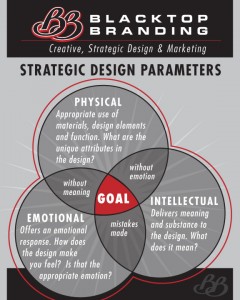I have been told that I am a great storyteller.
Depending on the situation, that can be a compliment or not.
One-time while on a road trip through the backroads of Vermont in search of covered bridges, I would make up ghost stories about driving through a road very much like this one, and when I came to a climactic point I’d touch the brakes to emphasize the point. It would scare the bejezus out of everyone from grand-daughters to grand-fathers riding in that van.
And when I was a kid and had to explain the bits and pieces of model cars in the backyard, I would quickly come up with a reason that did NOT involve firecrackers.

I have taken those lessons and what I had learned in Art History and Sculpture classes at the Laguna College of Art and Design to the benefit of my clients with my Strategic Design Parameters diagram. The diagram was developed for visual communication, however it works well for storytelling as well. Here we find the “sweet spot” between the Physical, Emotional and Intellectual parameters.
 A good story draws people in, compels them to learn more and leaves them feeling content. That’s the structure, or the Physical Parameter. The Intellectual Parameter is the part that compels them to learn more. There is something interesting, fascinating or educational that essentially sucks them in. Then there is the Emotional Parameter that pulls at their heartstrings and creates a bond.
A good story draws people in, compels them to learn more and leaves them feeling content. That’s the structure, or the Physical Parameter. The Intellectual Parameter is the part that compels them to learn more. There is something interesting, fascinating or educational that essentially sucks them in. Then there is the Emotional Parameter that pulls at their heartstrings and creates a bond.
1) Physical Parameter
Outline the structure of your story. Be sure that there is a beginning, middle and end. Sounds simple enough but without the plan, your story will ramble. I have found it best to define the ending first. What is the result you want someone to achieve at the end of the story? The beginning will create the question that the end will answer. The middle is the meat of the story. It will provide the support to create a paradigm shift in your audience and allow them to accept your solution in the end.
If there are problems in the Physical Parameter the message will be lost because the audience will be focused on the flaws. Spelling or grammatical errirs our grate exampuls.
2) Intellectual Parameter
As defined earlier in the meat of the story. The Intellectual Parameter is going to have a historical or contemporary reference that the audience will appreciate. For that to happen you must research your audience to use the proper references. Obscure references will distance you from the audience. Be careful not to overuse industry terms that they may not be aware of. Keep jargon at a minimum.
When there are flaws in the Intellectual Parameter the audience will not get the meaning of the message and cannot make an informed positive action. Be clear and concise in your meaning.
3) Emotional Parameter
In order for the audience to completely “buy-in” to your story it must touch them spiritually. An AHA moment. Something that will connect with them on a deeper more personal level. In researching your audience look for clues to what they are responding to. This could be as simple as a color choice, or as deep as a nostalgic remembrance.
A story may be well written, be full of meaning but without an equally strong emotional quotient, there will be no connection. It will be difficult for the audience to share the story. We need them to share the story with gusto!
I trust this article will help you in writing your STORY. If you would like to discuss how we can specifically assist you in your story, please feel free to call.
– Tony Colombini 949-584-5669
